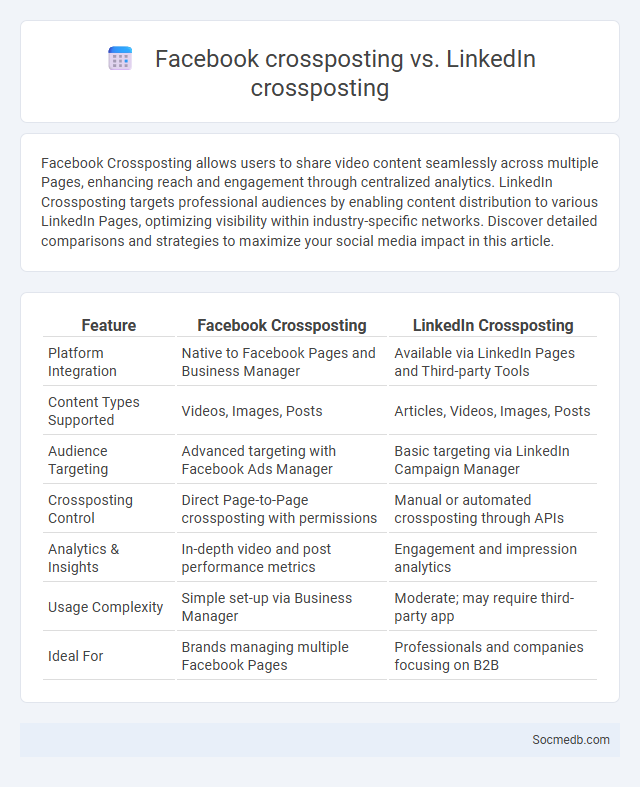
Photo illustration: Facebook Crossposting vs LinkedIn Crossposting
Facebook Crossposting allows users to share video content seamlessly across multiple Pages, enhancing reach and engagement through centralized analytics. LinkedIn Crossposting targets professional audiences by enabling content distribution to various LinkedIn Pages, optimizing visibility within industry-specific networks. Discover detailed comparisons and strategies to maximize your social media impact in this article.
Table of Comparison
| Feature | Facebook Crossposting | LinkedIn Crossposting |
|---|---|---|
| Platform Integration | Native to Facebook Pages and Business Manager | Available via LinkedIn Pages and Third-party Tools |
| Content Types Supported | Videos, Images, Posts | Articles, Videos, Images, Posts |
| Audience Targeting | Advanced targeting with Facebook Ads Manager | Basic targeting via LinkedIn Campaign Manager |
| Crossposting Control | Direct Page-to-Page crossposting with permissions | Manual or automated crossposting through APIs |
| Analytics & Insights | In-depth video and post performance metrics | Engagement and impression analytics |
| Usage Complexity | Simple set-up via Business Manager | Moderate; may require third-party app |
| Ideal For | Brands managing multiple Facebook Pages | Professionals and companies focusing on B2B |
Understanding Crossposting: Definition and Overview
Crossposting refers to the practice of sharing identical content across multiple social media platforms simultaneously to maximize reach and engagement. It enables brands and influencers to maintain a consistent message, streamline content management, and expand audience exposure without creating unique posts for each channel. Effective crossposting requires understanding platform-specific algorithms, optimal posting times, and tailored formatting to optimize visibility and user interaction.
The Importance of Social Media Crossposting
Social media crossposting maximizes your content reach by sharing the same post across multiple platforms, increasing visibility and engagement. This strategy saves time and maintains consistent messaging while tapping into diverse audience segments on platforms like Facebook, Instagram, and Twitter. Your brand benefits from broader exposure and streamlined content management by effectively leveraging crossposting techniques.
Facebook Crossposting: Key Features and Benefits
Facebook crossposting enables creators and brands to share the same video across multiple Facebook Pages without uploading it multiple times, ensuring consistent content delivery and saving time. This feature supports increased reach and engagement by allowing audiences across different pages to interact with the same post, while consolidated insights help track overall performance efficiently. Your social media strategy benefits from streamlined content management and amplified visibility through effective use of Facebook crossposting tools.
LinkedIn Crossposting: Unique Capabilities and Value
LinkedIn crossposting enables seamless sharing of content across multiple social media platforms while preserving LinkedIn's professional tone and network-specific engagement. Leveraging LinkedIn's unique features, such as targeted audience insights and industry-specific groups, enhances content visibility and drives meaningful B2B interactions. This capability streamlines content management, increases brand reach, and maximizes ROI by aligning with the platform's business-oriented environment.
Facebook vs LinkedIn: Crossposting Similarities and Differences
Facebook and LinkedIn both support crossposting, allowing users to share identical content across platforms to maximize reach, yet Facebook emphasizes personal engagement and multimedia-rich posts, while LinkedIn prioritizes professional tone and industry-specific content. Facebook's algorithm favors interactive posts with likes, shares, and comments from friends and family networks, whereas LinkedIn promotes posts that generate professional conversations and thought leadership within industry groups. Crossposting between these platforms requires content adaptation to respect Facebook's casual style and LinkedIn's formal context, ensuring optimal engagement for each audience.
Audience Engagement: Facebook vs LinkedIn Crossposted Content
Facebook drives higher audience engagement through interactive features like reactions, comments, and shares, appealing to broad demographic groups. LinkedIn fosters more professional and targeted engagement, especially for B2B content, with users more likely to participate in industry-relevant discussions and share career milestones. Crossposting content between Facebook and LinkedIn maximizes reach but requires tailoring messages to each platform's unique audience behavior and engagement patterns for optimal impact.
Best Practices for Effective Social Media Crossposting
Crossposting on social media maximizes content reach by sharing posts across multiple platforms while maintaining platform-specific formatting and audience preferences. Utilize scheduling tools like Hootsuite or Buffer to streamline posting times and avoid spamming followers. Tailor captions and hashtags to each platform's algorithm to enhance engagement and visibility.
Potential Pitfalls: Common Crossposting Mistakes to Avoid
Crossposting on social media can lead to potential pitfalls such as inconsistent messaging, audience misalignment, and diminished engagement. Your brand's voice may become diluted if identical content is shared across platforms without tailoring to each audience's preferences. Avoid these mistakes by customizing posts to fit the unique style and expectations of each social media channel, ensuring higher relevance and better interaction.
Analytics and Performance Tracking Across Platforms
Social media analytics leverage data from platforms like Facebook, Instagram, and Twitter to measure user engagement, reach, and conversion rates. Tools such as Google Analytics, Hootsuite, and Sprout Social provide comprehensive performance tracking by analyzing metrics like click-through rates, audience demographics, and content virality. Real-time data insights enable marketers to optimize campaigns, enhance targeting strategies, and improve overall ROI across multiple social media channels.
Choosing the Right Crossposting Strategy for Your Brand
Selecting the optimal crossposting strategy for your brand involves analyzing audience demographics across platforms such as Instagram, Facebook, TikTok, and LinkedIn to tailor content effectively. Leveraging platform-specific features like Instagram Stories, Facebook Groups, or LinkedIn Articles enhances engagement by matching content format with user expectations. Monitoring analytics and engagement metrics helps refine crossposting schedules, ensuring maximum reach while maintaining brand consistency across social media channels.
 socmedb.com
socmedb.com